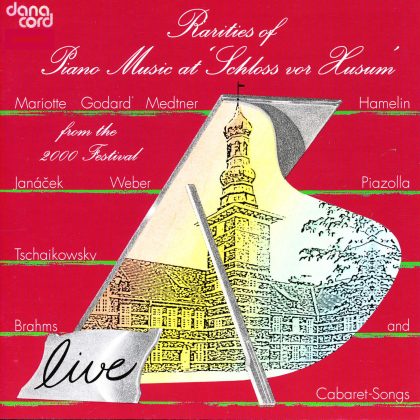Claude Debussy
24 Préludes pour Piano – 1er Livre (1910)
1. Lent et grave (… Danseuses de Delphes)
2. Modéré (… Voiles)
3. Animé (… Le vent dans la plaine)
4. Modéré (… “Les sons et les parfumes tournent dans l’air du soir” Ch. Baudelaire)
5. Très modéré (… Les collines d’Anacapri)
6. Triste et lent (… Des pas sur la neige)
7. Animé et tumultueux (… Ce qu’a vu le vent d’Ouest)
8. Trés calme et doucement expressif (… La fille aux cheveux de lin)
9. Modérément animé (… La sérénade interrompue)
10. Profondément calme (… La Cathédrale engloutie)
11. Capricieux et léger (… La danse de Puck)
12. Modéré (… Minstrels)
24 Préludes pour Piano – 2me Livre (1913)
1. Modéré (… Brouillards)
2. Lent et mélancolique (… Feuilles mortes)
3. Mouvement de Habanera (… La puerta del Vino)
4. Rapide et léger (… Les fées sont d’exquises danseuses)
5. Calme – Doucement expressif (… Bruyères)
6. Dans le style et le Mouvement d’un Cake-Walk (… “General Lavine” – eccentric -)
7. Lent (… La terrasse des audiences du clair de lune)
8. Scherzando (… Ondine)
9. Grave (… Hommage à S. Pickwick Esq. P.P.M.P.C.)
10. Trés calme et doucement triste (… Canope)
11. Modérément animé (… Les tierces alternées)
12. Modérément animé (… Feux d’artifice)
Debussy: 24 Préludes ©
“Musicien franqais” – that is how Claude Debussy liked to describe himself. But the term “impressionism” was attached to his music even during his own lifetime, and in the meantime he has come to be regarded as the leading exponent of the impressionist movement in music. ln fact, it may be justifiable to doubt whether there ever has been an impressionist movement as such in the world of music. Debussy had few imitators, and hardly any of real substance, even though it can be argued that his advances in harmony and instrumentation have been of importance for the film and light music of later generations.
The term impressionism originated in the art of painting and refers, popularly stated, to the idea of the artist reproducing not his motif itself but the impression the motif has had on him. Hence the vague, uncontoured, even shimmering effect of so-called impressionist painting. Similarly, Debussy attempts in some of his works to convey his impression of nature: “Clouds”, “The Sea” and “Moonlight” are typical of the titles of his works. and he called his greatest orchestral piece “lmages”, which may be translaled as “Reflections”. He incidentally also used this title for a number of his works for piano.
ln order to achieve what have been described as impressionistic effects in his music, Debussy departed from conventional, classical-romantic functional harmony, according to which the individual harmonies are related t0 each other and progress in a pattern determined by western music needs of tension and subsequent relaxation. Debussy accorded each harmony its own worth, thereby creating a world of harmony free of tension and suggestive of things motionless uncontoured. He also tried to avoid the diatonic scales, replacing them with the wholetone scale which is free of the semitones which characterize the major and minor (dialonic) scales. Far from all of Debussy’s works can however be described as impressionistic. Much of his work is marked by his affinity for the French musical past: he was a great admirer of the French “clavecinistes”, composers such as Couperin and Rameau, and many of his piano pieces are archaistic to some extent. In their works we find rhythmically vital and melodically bright music, built upon the functional harmony of earlier ages, and the names of the movements are those of the baroque suite.
RELEASE DATE: March 1998
CATALOGUE NUMBER.: DACOCD 505
EAN: 570949955007




